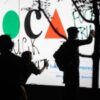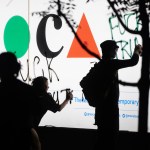Danny Killion, now of Troy, NY, was suicidal when he first entered Cheshire Correctional prison to serve time for a string of bank robberies. But he eventually found an outlet for his pain in art.
“My favorite thing to say about the Prison Arts Program is that it saved my life,” he said
Killion was speaking during the opening reception of the 44th annual Community Partners in Action Prison Arts Program exhibit in the Hans Weiss Newspace Gallery at CT State Community College Manchester.
Lindsey Joyce
“For me and probably every other artist you see here it gives you a real sense of purpose. It gives you the ability through this program to be connected to your community in a way that is unusual for prisons. Very often people who are incarcerated are kind of forgotten about by society,” he said.
The exhibit displays 619 pieces created by 159 prisoners from nine Connecticut prisons. The pieces feature a variety of mediums and celebrates the creativity of incarcerated people using art to express themselves and connect with their communities beyond the prison walls.
Program Manager Jeffrey Greene, who has taught art in prison for more than 20 years, offered perspective on the featured artists.
“Right now, we’re here,” said Greene. “Obviously this is so incredible and so beautiful and so fun to be here, and we have food to eat and we’re all around each other. But right at this moment everyone that’s participating in this show … all know that right now is the opening reception of their exhibition that they cannot come to.”
Greene is an ardent advocate for the importance of art as a means of self-expression for incarcerated people and contends “Art cannot be contained by a cell.”
“I have a great admiration for the work people do and the diversity of work that’s possible,” Greene said. “The first thing I learned right away seeing artists in prison was they were making art because they couldn’t help but make art. Because of who they were, where they were, and the needs they had. They need to express that they love people, that they need to be loved.”
On poignant example is a wooden, toddler-sized Adirondack chair created by Joshua Gray who is incarcerated at the Cheshire Correctional Institution. In his artist statement, Gray writes that though he cannot be with the grandchild he made it for, thanks to the Prison Arts Program he can share “a chair made with love.”
Justine Devitt
Friends and families of the artists came to the opening to show their support and embrace a sense of connection to their loved ones who could not be there. Alumni of the program, including Killion, were also in attendance, some giving personal testimonies about their experiences.
Vinny Nardone, another alum, has been affiliated with the program since 1989. He has now been out of prison for nine years and works driving tractor trailers.




Lindsey Joyce
“It created a bubble around me, so I wasn’t bitter, plain and simple… There was nothing else but my art,” Nardone said. “It gives these girls and guys a little self-esteem. They’re in a world where there is no escape and to say hey, I just had a piece shown at an art show in Manchester, that will be a conversation for quite a while, and it’s all brought about because of the CPA.”
The materials used by the artists range from the traditional like wood, ink and watercolors to the more creative. Ian Cooke created a guitar made of cardboard scavenged from legal pads and wheat paste glue. He gave his creation to his mother outside of the prison, Linda Cusano, who finished it off by painting images on the guitar face.
And Darryl Crenshaw created elaborate origami boxes that spin out of shampoo bottle tops, headphone wire, t-shirt thread and a glue made from toothpaste and creamer.
“Origami is the only thing that consistently brings peace of mind while in my cell,” Crenshaw writes in his artist statement accompanying his three boxes on display.
The CPA’s Prison Arts Program’s impact is far reaching, and it is beginning to attract attention beyond the state. At the show opening, Executive Director Beth Hines announced that the program was just awarded a grant by the National Endowment for the Arts’ ArtsHERE program, which supports historically underserved communities. Out of 4,000 applicants, they were one of only 112 chosen for the honor.
“This will put this program in the national spotlight,” Hines said. “This is incredible work by people who are in incredible situations and trauma they have experienced, and yet look at what they are able to produce … It’s just staggering.”
Lindsey Joyce
Killion, a Connecticut native, now owns and operates a gallery and showroom called Weathered Wood in Troy. Still he returns every year for the opening of the exhibit, to see the new art and support the program that gave him a path to follow outside the prison walls.
“The art program was the best thing in the whole prison system,” Killion said. “It just gives you something to concentrate on that has hope, a bright spot in your life.”
The Prison Arts Program Annual Show exhibit runs through Nov. 13 in the Hans Weiss Newspace Gallery on the first floor of the Arts, Sciences and Technology building, and is free to visit.
Greene will give a presentation about the program Oct. 22 at 1 p.m. in the SBM Charitable Foundation Auditorium, which is free and open to the public.
The exhibit’s closing reception will be held Saturday, Nov. 9, from noon to 2 p.m. For more information about the gallery, including hours, visit the Hans Weiss Newspace Gallery website.
Erin Rutledge is a student at CT State Community College Manchester
This post was originally published on this site be sure to check out more of their content.






